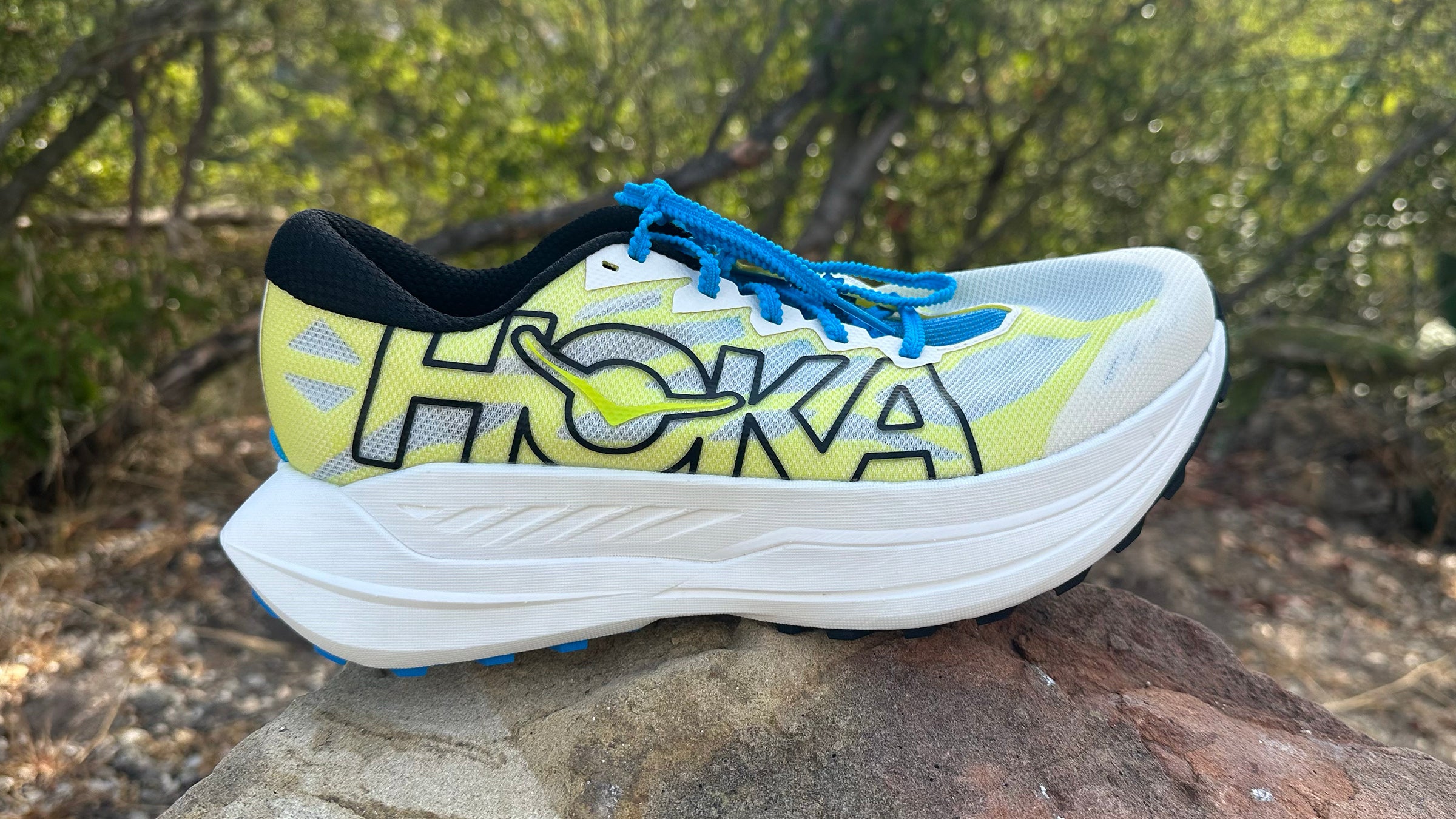If you buy through our links, we may earn an affiliate commission. This supports our mission to get more people active and outside.Learn about Outside Online's affiliate link policy
Hoka Rocket X Trail Review: Fast, Fun, Groomed-Trail Racer

Hoka's new trail super shoe leverages top-tier, responsive A-TPU foam and a split, parallel plate for a speedy ride. (Photo: Cory Smith)
Hoka is known for teasing new models during high-profile races. In late June this year, Fuzhao Xiang finished second at the Western States 100 in an unreleased ultra-cushioned model. We now know what Xiang was wearing: The Hoka Rocket X Trail, a dirt-ready version of Hoka’s road super shoe. We got our hands on a pair before its official release and have been testing it on our favorite trails. Here’s how it performed.
Watch: Hoka Rocket X Trail Reviewed
Hoka Rocket X Trail: At-a-Glance
Weight: 9.5 oz (men’s 10); 8.0 oz (women’s 8)
Stack Height: 42–36 mm
Heel-to-toe Drop: 6 mm
Lugs: 3 mm
Pros
- Lightweight for a high-cushioned trail shoe
- A-TPU foam delivers responsive, soft-yet-protective cushioning
- H-shaped carbon-fiber plate balances propulsion and adaptability
- Wide forefoot improves stability
- Upper locks down securely
Cons
- Too unstable for mountain running or highly technical singletrack
- 3 mm lugs and only partial outsole coverage limit grip on loose terrain
- Stiff forefoot reduces adaptability
Hoka Rocket X Trail First Impressions

(Photo: Cory Smith)
I love Hoka’s ultra-cushioned, carbon-fiber-plated road super shoe, the Rocket X, so this trail shoe that shares its name immediately caught my attention. I received a pair two weeks before its September 1 release date and quickly took it out on the trails.
Hoka markets the Rocket X Trail as “a shoe designed specifically for the demands of gravel racing.” Knowing that, I took it up to one of my favorite climbs here in Santa Barbara: Tunnel Trail. It’s a winding three-mile fire road that climbs 1,500 feet—the quintessential gravel surface—with singletrack offshoots perfect for testing a shoe’s technical capabilities.
Structurally, the Rocket X Trail is a well-built, good-looking shoe. The beveled heel, shaped almost like fox ears, gives it an explosive, rocket-like silhouette to match its name. At sub-10 ounces for men and eight ounces for women, it’s also very lightweight. That is about the only thing it shares with its road shoe namesake.
The midsole is an entirely new foam for Hoka, made from gas-infused A-TPU. I’ve been writing a lot about A-TPU as it’s quickly becoming the gold standard foam for high-end racing models, both on road and trail. PUMA was the first to use it in a trail shoe with the Deviate Nitro Elite Trail, which impressed our test team. However, the magic is in how each brand curates the foam and how they tune its ride with geometry and plates. Embedded in the Rocket X Trail’s thick 42–36mm stack height is an H-shaped, split, parallel carbon fiber plate, similar to that found in the Tecton X but without winglets.
My testing quickly convinced me Hoka nailed it with this one. My first steps on the Tunnel Trail were on a steep road leading to the trailhead. The Rocket X Trail felt great: stable, responsive, and comfortable. The 3mm lugs didn’t feel harsh on pavement, which was a pleasant surprise.
As the trail transitioned to a packed-dirt fire road and my legs began to warm up, the shoe continued to impress. The forefoot is fairly stiff, limiting flex at the metatarsals, but a subtle rocker helped keep things rolling forward. Despite the stiffness, I didn’t really notice the plate during the run. The cushioning delivered that happy middle ground between firmly responsive and protectively soft.
Before turning around and starting the descent, I stopped to tighten the fit. The upper is made with an abrasive mesh with zonal overlays for structure and a minimally padded tongue. As I pulled on the sawtooth laces, I was impressed with how the upper wrapped my foot securely, yet stayed comfortable. I hate when trail shoes have a flimsy upper, especially when it has a high stack height. I want the upper to grab my feet and lock it down on the midsole—and the Rocket X Trail did exactly that.
As I made my way down, the shoe behaved as expected for a trail super shoe. Every so often I hit patches of loose dirt and rocks that put the traction to the test. While it was generally good, I couldn’t shake the slight hesitation that I might skid out. On loose, shifty surfaces, the limitations of the three-millimeter lugs and partial outsole coverage became more noticeable.

On the way up, and at slower paces, the Rocket X Trail had felt surprisingly stable. The forefoot is incredibly wide, which really goes a long way in stabilizing the height. But on the descents, as the pace quickened, I noticed that any off-camber surface required extra effort to stay steady.
Halfway down, I cut off onto a technical single track to test what I assumed would be torturous running. Sure enough, I immediately tensed up and became cautious. Between the high stack height and wide footprint that made it difficult to slot into tight spaces between rocks, the shoe was out of its element. I was grateful to get back to the smoother gravel and let the shoe fly home.
Hoka Rocket X Trail: Who Is It For?
Hoka markets the Rocket X Trail as designed for gravel racing. By default, that makes it clear this isn’t a technical or mountain running shoe. As such, it complements the more agile Tecton X3 in Hoka’s lineup. It isn’t, however, limited to dirt roads. This is a perfectly capable trail shoe; it just needs to stay on smooth terrain.
Any runner who likes to push themselves—and stays on good footing—will find the Rocket X Trail is incredibly fun and fast as hell.